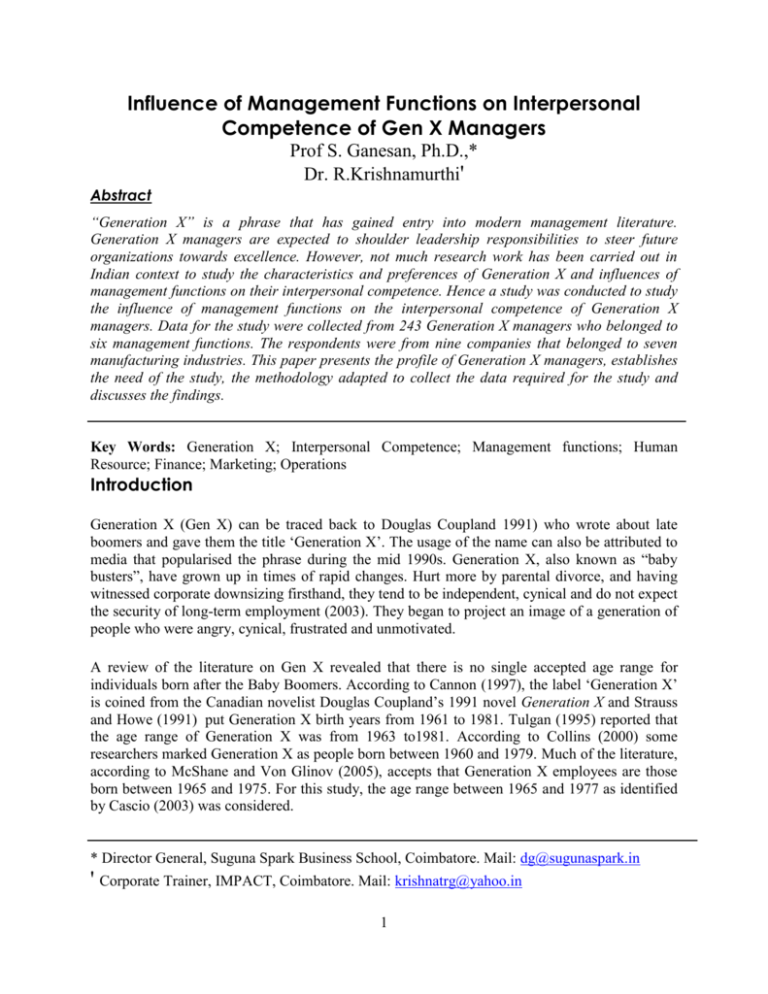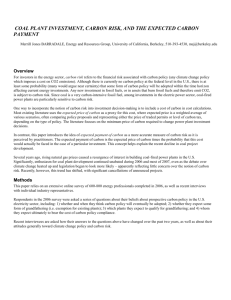Copy
advertisement

Influence of Management Functions on Interpersonal Competence of Gen X Managers Prof S. Ganesan, Ph.D.,* Dr. R.Krishnamurthi' Abstract “Generation X” is a phrase that has gained entry into modern management literature. Generation X managers are expected to shoulder leadership responsibilities to steer future organizations towards excellence. However, not much research work has been carried out in Indian context to study the characteristics and preferences of Generation X and influences of management functions on their interpersonal competence. Hence a study was conducted to study the influence of management functions on the interpersonal competence of Generation X managers. Data for the study were collected from 243 Generation X managers who belonged to six management functions. The respondents were from nine companies that belonged to seven manufacturing industries. This paper presents the profile of Generation X managers, establishes the need of the study, the methodology adapted to collect the data required for the study and discusses the findings. Key Words: Generation X; Interpersonal Competence; Management functions; Human Resource; Finance; Marketing; Operations Introduction Generation X (Gen X) can be traced back to Douglas Coupland 1991) who wrote about late boomers and gave them the title ‘Generation X’. The usage of the name can also be attributed to media that popularised the phrase during the mid 1990s. Generation X, also known as “baby busters”, have grown up in times of rapid changes. Hurt more by parental divorce, and having witnessed corporate downsizing firsthand, they tend to be independent, cynical and do not expect the security of long-term employment (2003). They began to project an image of a generation of people who were angry, cynical, frustrated and unmotivated. A review of the literature on Gen X revealed that there is no single accepted age range for individuals born after the Baby Boomers. According to Cannon (1997), the label ‘Generation X’ is coined from the Canadian novelist Douglas Coupland’s 1991 novel Generation X and Strauss and Howe (1991) put Generation X birth years from 1961 to 1981. Tulgan (1995) reported that the age range of Generation X was from 1963 to1981. According to Collins (2000) some researchers marked Generation X as people born between 1960 and 1979. Much of the literature, according to McShane and Von Glinov (2005), accepts that Generation X employees are those born between 1965 and 1975. For this study, the age range between 1965 and 1977 as identified by Cascio (2003) was considered. * Director General, Suguna Spark Business School, Coimbatore. Mail: dg@sugunaspark.in ' Corporate Trainer, IMPACT, Coimbatore. Mail: krishnatrg@yahoo.in 1 Need of the Study An extensive study on the outstanding performers revealed, as per Moss (1929), that their success depended not on their deep and profound knowledge which challenged the brains of average people but on the simple and more commonplace qualities which pleased the understanding of the common people, and aroused in their hearts a feeling of sympathy. A study by the Institute of Management Accountants found that ‘interpersonal skills’ were most important for success as professional accountants. Professional accounting practices, claimed Akers and Porter (2003), had placed little emphasis on behavioral issues such as interpersonal relationships although human behavior underlined most of what was written and taught about professional accounting. Interpersonal Competence (IC) is defined by Buhrmester and Wittenberg (1988) as: “Relating well to all kinds of people (both within and across groups) regardless of level, inside or outside of organization, building effective relationships, using tact and diplomacy when dealing with and interacting with others, working effectively with others to achieve common goals.” Chris Argyris (1962) emphasised the importance of interpersonal competence in the workplace in 1962. What he envisioned is relevant even in the present day workplace. “Without interpersonal competence or a ‘psychologically safe’ environment, an organisation is a breeding ground for mistrust, intergroup conflict, rigidity and so on, which in turn lead to a decrease in organisational success in problem solving.” Raymond (1974) examined the relationship between interpersonal needs of MBA professionals and their preferences for a functional area of management. The study found significant differences in interpersonal skills among professionals belonging to different management functions such as accounting, marketing, human resource and production and operations. Hence, a study was attempted to study the influence of management functions on interpersonal competence of Gen X managers. Methodology Table 1.1 Distribution Of Respondents Of IC Across Management Functions No Management Functions Gen X Managers % of total sample 1 Finance 20 8.23 2 GA 27 11.11 3 HR 47 19.34 4 Logistics 50 20.58 5 Marketing 20 8.23 6 Operations 79 32.51 Total 243 2 100 Data for the research study, as given in Table 1.1, were collected from 243 Gen X managers who belonged to nine manufacturing industry. ‘Interpersonal Competence’ questionnaire designed by the Researcher was used to measure the interpersonal competence of the respondents. The questionnaire comprised 83 items with five point responses ranging from ‘Strongly Disagree’ (1 point) to ‘Strongly Agree’ (5 points). Hence, minimum and maximum scores were 83 and 415 respectively. The respondents of the study belonged to six management functions, viz., Finance, General Administration (GA), Human Resource (HR), Logistics, Marketing and Operations. Each management function had various sub functions. Finance function included Corporate Accounting, Planning & Budgeting, Internal Auditing, Costing, Investor Relations and Portfolio Management. General Administration encompassed Safety & Security, Office Administration, House Keeping, Transportation, Canteen and Corporate Affairs. Human Resources function consisted of Personnel and Administration, Employee Relations, Recruitment, Counselling, Training and Development, Community Development and Employee Welfare. Logistics function covered Procurement, Maintenance, Distribution and Export Management. Marketing function contained Strategy, New Product Development, Marketing, Sales, Promotion, Service and Customer Relationship Management. And Operations function comprised Production, Research and Development, Paint Shop, Assembly, Press shop, Machine Shop, Case Shop, Design and Quality Assurance. Discussions Based on previous research findings, it was understood that interpersonal relationships of the respondents was influenced by their management functions. The mean scores of IC of the respondents, as presented in table 1.2, from different management functions were taken to study the differences and verify the previous findings. Table 1.2 IC With Reference To Management Functions Management Functions Number of Responses Finance GA HR Logistics Marketing Operations Scale Mean Values Strongly Disagree Disagree Moderately Agree Agree Strongly Agree 20 64 201 400 532 463 305.45 27 139 296 559 801 446 290.44 47 239 345 643 1380 1294 315.91 50 239 502 1066 1434 909 294.44 20 77 236 433 610 304 290.40 79 336 969 1778 2099 1375 289.56 3 The mean scores show that there were differences in the levels of IC among the respondents who belonged to different management functions. The respondents from Operations function had the lowest mean score (289.56) and the respondents from Human Resource function had the highest mean score (315.91). The differences in the mean scores among Finance, Logistics, Marketing and Operations function were very subtle. Since the differences were not observable, a hypothesis was formulated to statistically verify the differences. It is, ‘The levels of IC of Gen X managers vary with regard to their management functions.’ NH: Gen X managers from different management functions have same level of IC. AH: Gen X managers from different management functions do not have same level of IC. The results of ANOVA test, as presented in Table 1.3, show that there is significant difference in the levels of IC of the respondents who belonged to different management functions. It is concluded that management functions had an influence on IC of Gen X managers. Hence, PostHoc test was conducted to find out the management function that had the maximum influence on the IC of the respondents. Table 1.3 Analysis Of Variance In IC Among Management Functions Attribute Interpersonal Competence Between Groups Within Groups Total Sum of Squares df 5093.07 222752.17 227845.24 5 237 242 Mean Square 4991.89 856.05 F Sig. Result 5.83 0.000 <0.05 - null hypothesis is rejected From the Post-Hoc analysis, as given in Table 1.4, it is derived that the respondents who belonged to Human Resource function had significantly the highest level of IC and the respondents who belonged to Operations function had the lowest level of IC among the respondents from Finance, Marketing, Logistics and General Administration functions. There was no difference in the levels of IC among the respondents from to Human Resource and Finance functions. Though differences in IC existed among the respondents who belonged to other management functions, they were not significant. The study was further extended to study the influence of management functions on the dimensions of IC. Table 1.4 Differences In IC Among Management Functions Management M.D Sig. Functions HR Marketing 25.51* 0.016 Finance 10.46 0.763 Interpersonal Operations 26.34* 0.000 Competence Logistics 21.47* 0.005 GA 25.47* 0.005 * The mean difference is significant at the .05 level. Attribute 4 Result < 0.05- difference is significant < 0.05- difference is significant < 0.05- difference is significant < 0.05- difference is significant Management Functions & IC Dimensions Table 1.5 Management Functions IC Dimensions With Reference To Management Functions Number of Responses Finance GA HR Logistics Marketing Operations 20 27 47 50 20 79 Finance GA HR Logistics Marketing Operations 20 27 47 50 20 79 Finance GA HR Logistics Marketing Operations 20 27 47 50 20 79 Finance GA HR Logistics Marketing Operations 20 27 47 50 20 79 Finance GA HR Logistics Marketing Operations 20 27 47 50 20 79 Scale Strongly Disagree Disagree Moderately Agree Listening 10 38 80 28 51 107 59 58 118 35 92 208 10 28 76 61 177 374 Rapport Building 15 46 85 36 59 128 53 71 137 47 104 233 17 44 95 74 217 355 Initiative 20 56 87 31 74 134 61 94 167 71 120 271 14 65 102 93 259 398 Respecting Others 7 22 62 23 45 89 30 54 93 26 81 183 17 36 72 48 138 333 Social Intelligence 20 31 80 23 67 97 47 56 128 58 107 172 14 46 78 71 184 321 5 Mean Values Agree Strongly Agree 112 174 294 315 136 436 100 99 270 200 90 295 63.70 60.88 65.00 62.06 64.40 60.81 109 158 256 296 128 439 85 78 282 170 56 258 61.15 57.77 64.68 59.76 59.10 58.46 108 166 276 255 109 363 69 54 201 133 50 230 58.50 56.11 60.83 56.18 56.80 55.78 109 168 276 307 133 450 120 107 299 203 62 295 63.65 58.77 64.17 59.60 57.35 58.20 98 137 273 261 115 394 91 108 248 202 67 294 58.45 56.88 61.17 56.84 56.75 56.30 A further study was carried out to find the dimensions of IC that had the maximum and minimum influences on the IC of Gen X managers. The instrument had five dimensions. They were: Listening, Rapport Building, Initiative, Respecting Others and Social Intelligence. Mean scores, as presented in Table 1.5, show that there were differences in the levels of various dimensions of IC among the respondents who belonged to different management functions. In Listening dimension, the respondents from Human Resource function had the highest mean score (65.00) and the respondents from Operations function had the lowest mean score (60.81). In Rapport Building dimension, the respondents from Human Resource function had the highest mean score (64.68) and the respondents from General Administration had the lowest mean score (57.77). In Initiative dimension, the respondents from Human Resource function had the highest mean score (60.83) and the respondents who belonged to Operations function had the lowest mean score (55.78). In Respecting Others dimension, the respondents who belonged to Human Resource function had the highest mean score (64.17) and the respondents from Marketing function had the lowest mean score (57.35). In Social Intelligence dimension, the respondents from Human Resource function had the highest mean score (61.17) and the respondents from Operations function had the lowest mean score (56.30). The differences in mean scores were evident in Respecting Others and Social Intelligence dimensions, but not apparent in Listening, Rapport Building and Initiative dimensions. To study the distinction in differences it is hypothesized as ‘Gen X managers from different management functions have different levels of: Listening, Rapport Building, Initiative, Respecting Others and Social Intelligence.’ NH: Gen X managers from different management functions have same level of: Listening, Rapport Building, Initiative, Respecting Others and Social Intelligence. AH: Gen X managers from different management functions do not have same level of: Listening, Rapport Building, Initiative, Respecting Others and Social Intelligence. Table 1.6 Analysis Of Variance In IC Dimensions Among Management Functions Dimensions Listening Between Groups Within Groups Total Rapport Building Between Groups Within Groups Total Initiative Between Groups Within Groups Total Respecting Others Between Groups Within Groups Sum of Squares df 675.30 13172.63 13848.00 5 237 242 1389.76 13432.02 14821.78 Mean Square F Sig. Result 135.07 55.58 2.43 0.036 <0.05- Null hypothesis is rejected 5 237 242 277.95 56.67 4.90 920.46 11306.05 12226.51 5 237 242 184.92 47.70 3.85 1526.02 10277.16 5 237 305.20 43.36 7.03 6 0.000 0.002 0.000 <0.05- Null hypothesis is rejected <0.05- Null hypothesis is rejected <0.05- Null hypothesis is rejected Total Social Intelligence Between Groups Within Groups Total 11803.18 242 802.97 9501.43 10304.40 5 237 242 160.59 40.09 4.00 0.002 <0.05- Null hypothesis is rejected ANOVA test was applied to check whether Gen X managers from different management functions have different levels of EI dimensions. The results of ANOVA test, as presented in Table 1.6, show that there are significant differences in the levels of different dimensions of IC among the respondents who belonged to various management functions as the null hypothesis ‘Gen X managers from different management functions have same level of: Listening, Rapport Building, Initiative, Respecting Others and Social Intelligence’ is rejected. So, it is concluded that the management functions of the respondents influenced all the dimensions of IC. Post-Hoc analysis was conducted to find out the management function that had the maximum influence on Listening, Rapport Building, Initiative, Respecting Others and Social Intelligence of the respondents. From the Post-Hoc analysis, as given in Table 1.7, the following results are derived. In the Listening dimension, the respondents who belonged to Human Resource had significantly higher level of Listening than the respondents who belonged to Operations. Though differences in Listening existed among the respondents from other management functions, they were not significant. In the Rapport Building dimension, the respondents from Human Resource function had significantly the highest level of Rapport Building among the respondents who belonged to Operations, Logistics and General Administration functions. Though differences in Rapport Building existed among the respondents from other management functions, they were not significant. In the Initiative dimension, the respondents who belonged to Human Resource function had significantly the highest level of Initiative among the respondents of Operations, Logistics and General Administration functions. Though differences existed in Initiative among the respondents from other management functions, they were not significant. Table 1.7 Dimensions Listening Rapport Building Initiative Differences In IC Dimensions With Reference To Management Functions Management Functions HR Marketing Finance Operations Logistics GA HR Marketing Finance Operations Logistics GA HR Marketing Finance M.D Sig. 4.60 1.30 4.18* 2.94 4.11 5.58 3.53 6.21* 4.92* 6.90* 4.09 2.39 0.194 0.987 0.030 0.380 0.205 0.065 0.496 0.000 0.018 0.003 0.232 0.786 7 Result < 0.05- difference is significant < 0.05- difference is significant < 0.05- difference is significant < 0.05- difference is significant Operations 5.10* 0.001 Logistics 4.71* 0.012 GA 4.78* 0.051 HR Marketing 6.82* 0.002 Finance 0.52 1.000 Respecting Operations 5.96* 0.000 Others Logistics 4.57* 0.010 GA 5.39* 0.010 HR Marketing 4.42 0.098 Finance 2.72 0.593 Social Operations 4.86* 0.001 intelligence Logistics 4.33* 0.011 GA 4.28 0.061 * The mean difference is significant at the .05 level. < 0.05- difference is significant < 0.05- difference is significant < 0.05- difference is significant < 0.05- difference is significant < 0.05- difference is significant < 0.05- difference is significant < 0.05- difference is significant < 0.05- difference is significant < 0.05- difference is significant In the Respecting Others dimension, the respondents who belonged to Human Resource function had significantly the highest level of Respecting Others among the respondents from Marketing, Operations, Logistics and General Administration functions. Though differences in Respecting Others existed among the respondents who belonged to other functions, they were not significant. In the Social Intelligence dimension, the respondents who belonged to Human Resource function had significantly the highest level of Social Intelligence among the respondents from Operations and Logistics functions. There were differences in the levels of various dimensions of IC among the respondents. Respondents from Human Resource function scored high in all the five dimensions of IC and the respondents who belonged to Operations function scored low in Listening, Initiative and Social Intelligence, the respondents from Marketing function scored low in Respecting Others and the respondents from General Administration scored low in Rapport Building. Conclusion There were significant differences in the levels of IC of Gen X managers from different management functions. The respondents who belonged to Human Resource function had the highest IC and the respondents who belonged to Operations function had the lowest IC. There were differences in the levels of various dimensions of IC among the respondents. The respondents who belonged to Human Resource function scored high in all the five dimensions of IC and the respondents who belonged to Operations function scored low in Listening, Initiative and Social Intelligence. The respondents who belonged to Marketing function scored low in Respecting Others and the respondents who belonged to General Administration scored low in Rapport Building. 8 References Buhrmester, D. Furman. and Wittenberg, Reis H. (1988) ‘Five Domains of Interpersonal competence in peer relationships,’ Journal of Personality and Social Psychology, Vol.55, Issue 4, pp. 991-1008. Cannon, D. (1997) Generation X and the New Work Ethics, London: Demos. Chris, Argyris. (1962) Interpersonal Competence and Organisational Effectiveness, Illinois: Tavistock Publications. Collins, M. (2000) ‘Generation X-Review,’ Journal of Career Planning and Employment, Vol.12, Issue 3, pp. 65-74. Douglas, Coupland. (1991) Generation X: Tales for an Accelerated Culture, Abacus: St Martin’s Press. Hill, Raymond.E. (1974) ‘Interpersonal Needs and Functional Area of Management,’ Journal of Vocational Behaviour, Vol. 4, Issue 1, pp. 15-24. McShane, L Steven. and Von Glinov, Mary Ann. (2005) Organizational Behavior, New Delhi: Tata-McGraw Hill. Michael, D Akers and Grover, L Porter. (2003) ‘Your EQ Skills: Got what it Takes?’ Journal of Accountancy, March, pp. 65-69. Moss, F.A. (1929) Applications of Psychology, Cambridge, M.A: Riverside Press. Strauss, W. and Howe, N. (1991) Generations: The History of America’s Future 1584-2069, New York: William Morrow and Company Inc. Tulgan, Bruce. (1995) Managing Generation X: How to bring out the best in young talent, New York: Merrit Publishing. Wayne, F. Cascio. (2003) Managing Human Resources: Productivity, Quality of Work life and Profits, New Delhi: Tata McGraw-Hill. 9






